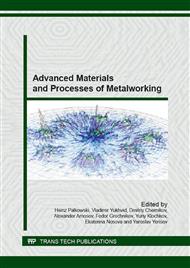[1]
А{TTP}1040 . Gazizulina, Method for analyzing the quality of standardization, The DQM research. 6 (2015) 23-38.
Google Scholar
[2]
B. Prasad, Concurrent Engineering Fundamentals: Integrated Product and Process Organization, Prentice Hall, Englewood Cliffs, NJ (1996).
Google Scholar
[3]
D. Xue, S. Yadav, D.H. Norrie, Knowledge base and database representation for intelligent concurrent design, Computer Aided Design. 31 (1999) 131–145.
DOI: 10.1016/s0010-4485(99)00021-4
Google Scholar
[4]
Y. -M. Deng, G.A. Britton, Y.C. Lam, S.B. Tor, Y. -S. Ma, Feature-based CAD-CAE integration model for injection moulded product design, International Journal of Products Research. 40(15) (2002) 3737–3750.
DOI: 10.1080/00207540210141643
Google Scholar
[5]
G.A. Britton, S.B. Tor, Y.C. Lam, Y-M. Deng, Modelling functional design information for injection mould design, Int J Prod Res. 39(12) (2001) 2501–2515.
DOI: 10.1080/00207540110048954
Google Scholar
[6]
M.W. Fu, J.Y.H. Fuh, A.Y.C. Nee, Core and cavity generation method in injection mould design, Int J Prod, 39(1) (2001) 121-138.
DOI: 10.1080/00207540010002379
Google Scholar
[7]
Y-S. Ma, S.B. Tor, G.A. Britton, The development of a standard component library for plastic injection mould design using an object oriented approach, Int J Adv Manuf Technol. 22(9–10) (2003) 611–618.
DOI: 10.1007/s00170-003-1555-8
Google Scholar
[8]
W.V. Holland, W.F. Bronsvoort, Assembly features in {TTP}8232 modeling and planning, Robot ComInt Manuf. 16(4) (2000) 277–294.
Google Scholar
[9]
Y-S. Ma, T. Tong, Associative feature modeling for concurrent engineering integration. Comput Ind. 51(1) (2003) 51–71.
DOI: 10.1016/s0166-3615(03)00025-3
Google Scholar
[10]
D.E. Whitney, G. Shukla, S.V. Praun, A design procedure applicable to different classes of assemblies. Proceedings of DETC'01, ASME 2001 design engineering technical conferences and computers and information in engineering con- ference, Pittsburgh, PA (2001).
DOI: 10.1115/detc2001/cie-21304
Google Scholar
[11]
X.F. Zha, H.J. Du, J.H. Qiu, Knowledge-based approach and system for assembly oriented design, part I: the approach, Eng Appl Artif Intell. 14(1) (2001) 61–75.
DOI: 10.1016/s0952-1976(00)00060-9
Google Scholar
[12]
X.F. Zha, H.J. Du, A PDES/STEP-based model and system for concurrent integrated design and assembly planning, Comput Aided Des. 34(14) (2002) 1087–1110.
DOI: 10.1016/s0010-4485(01)00186-5
Google Scholar
[13]
W.Y. Zhang, S.B. Tor, G.A. Britton, A two-level modeling approach to acquire functional design knowledge in engineering systems, Int J Adv Manuf Technol. 19(6) (2002) 454–460.
DOI: 10.1007/s001700200048
Google Scholar
[14]
H.E. Otto, From concepts to consistent object specifications: translation of a domain-oriented feature framework into practice, J Comput Sci Technol 16(3) (2001) 208–230.
DOI: 10.1007/bf02943200
Google Scholar


